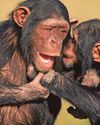CATEGORIES
Kategorien

Would you eat insects to save the planet?
Some say you should be eating beetles for breakfast and locusts for lunch.

Why are people allergic to things?
Find out why your body is sensitive to some substances.

Chimpanzees chat just like humans
Scientists know that chimpanzees are a lot like humans – we both have a common ancestor and share about 98.6% of our DNA (a special chemical that tells your body how to grow and develop).

Secret caverns found on the Moon
Could Moon caves provide shelter for future humans?

WHIZ KIDS
Claire Karwowski asks what makes people tick and if there is a secret to being smart.

Big Manny
Meet social media's science sensation.

Inside The Sky At Night - Two years ago, exoplanet scientist Hannah Wakeford received some of the first data from the JWST
Two years ago, exoplanet scientist Hannah Wakeford received some of the first data from the JWST. In July's Sky at Night, we discovered what she's learned since then.

Where Have All The Milky Way's Early Stars Gone?- Our Galaxy has a curious lack of pristine stars
The Big Bang produced a Universe filled almost exclusively with hydrogen and helium; all other elements - what astronomers call metals - were produced by stars, supernovae and everything that happens later. So if you can pick out a pristine star with no metals polluting it from among the billions in the Milky Way, then you are likely to have a star dating from our Galaxy's earliest days.

Could We Find Aliens by Looking for Their Solar Panels?- Designed to reflect ultraviolet and infrared, the panels have a unique fingerprint
Researchers searching for life beyond Earth spend a lot of time thinking about what telltale signs might be detectable astronomically. Forms of unambiguous evidence for the presence of life on another world are known as biosignatures. By extension, techno signatures are indicators of activity by intelligent, civilisation-building life.

Antimatter- In our continuing series, Govert Schilling looks at antimatter, the strange counterpart to most of the matter filling our Universe
Particles and corresponding antiparticles are very much alike, except they have opposite electrical charges. For instance, the antiparticle of the electron - known as the positron - has the same tiny mass, but while electrons carry a negative electrical charge, positrons are positively charged.

Flying over TITAN
Ezzy Pearson reports on NASA's Dragonfly, the first-ever science mission to fly on another world, which is set to soar over Saturn's largest moon in search of the elements of life

How to plot a variable star light curve
A rewarding project to chart stars that change brightness

Lunar occultation of Saturn
You'll need to strike a balance on 21 August to capture the Moon covering the ringed planet

Smartphone photography with a telescope
Mary Mcintyre explains how to get impressive night-sky images using your phone

How to stack DSLR data in Siril
Easily combine multiple frames to boost detailin your astro photos

The new era of human spaceflight
There's been a step-change in crewed space missions since the dawn of the 21st century. Ben Evans charts its course and looks ahead to future horizons

Once-a-century solar storm is overdue
If a Carrington Event struck today it would be catastrophic, says Minna Palmroth

Has Webb broken cosmology?
Caroline Harper

Shooting the dark Universe with THE WORLD'S BIGGEST CAMERA
Janie Carter reports _ from the Vera Rubin Observatory in Chile, where the largest camera ever built will soon start shooting the ultimate space movie: an ultra-wide, ultrahigh-definition record of the southern sky

Solar power generates enough heat to power a steel furnace
Scientists have used solar power to heat an object to 1,000 degrees Celsius - hot enough to power a steel furnace.

A new study shows crows can count out loud
Crows can count out loud, a startling new study has revealed, and they may even have the same numeracy skills as human toddlers.

The bizarre evolutionary roots of upside-down baobab trees revealed
The iconic 'upside-down' baobab tree first emerged on the island of Madagascar, new research into its tangled evolutionary history has revealed.

HOW AEROPLANE ESCAPE HATCHES WORK
Discover the engineering that allows an entire commercial aircraft to be evacuated in under two minutes

New antivenom invented for black widow spider bites
Scientists have invented a new antivenom for European black widow spider bites that uses human antibodies to mitigate the effects of the arachnid’s painful toxins.

HOW ANIMALS LIVE IN EXTREMES
Surviving in some of the world's harshest environments is tough, but not for these robust species

HOW TO OPERATE ON THE BRAIN
The procedures and surgical techniques that tackle problems inside your skull

AMAZING OLYMPIC INNOVATIONS
The 2024 Summer Olympics comes with an array of inspired inventions, from performance-enhancing footwear to Al-powered judges

50,000-year-old Neanderthal bones harbour the oldest known human viruses
Meanderthals who lived 50,000 years ago were infected with three viruses that still affect modern humans today, researchers have discovered.

The James Webb Space Telescope sees the birth of three ancient galaxies
Astronomers using the James Webb Space Telescope may have detected some of the earliest galaxies in the known universe in the midst of being born.

Canadian 'super pigs' are likely to invade the northern US
Feral 'super pigs' in Canada could soon trample across the US border.